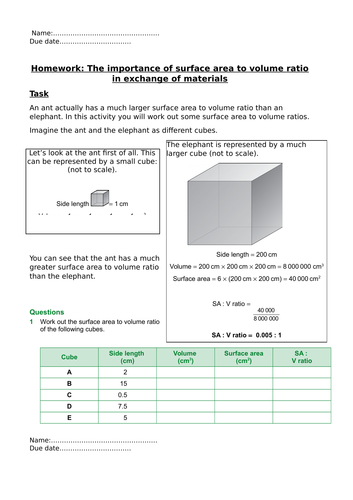


Exchanging materials lesson created in accordance to the NEW AQA Specification (9-1). Designed for a higher ability separates class, although content can be adjusted to suit any ability. Includes: slide animations, practice questions with answers on slides, worksheet, and homework (with MS)
AQA spec link: 4.1.3.1
Relevant chapter: B1 Cell structure and transport. AQA Biology third edition textbook-Page 22-23
Specification requires students to know the following;
A single-celled organism has a relatively large surface area to volume ratio. This allows sufficient transport of molecules into and out of the cell to meet the needs of the organism. Students should be able to calculate and compare surface area to volume ratios. Students should be able to explain the need for exchange surfaces and a transport system in multicellular organisms in terms of surface area to volume ratio.
Students should be able to explain how the small intestine and lungs in mammals, gills in fish, and the roots and leaves in plants, are adapted for exchanging materials. In multicellular organisms, surfaces and organ systems are specialised for exchanging materials. This is to allow sufficient molecules to
be transported into and out of cells for the organism’s needs.
The effectiveness of an exchange surface is increased by:
•• having a large surface area
•• a membrane that is thin, to provide a short diffusion path
•• (in animals) having an efficient blood supply
•• (in animals, for gaseous exchange) being ventilated.
Get this resource as part of a bundle and save up to 34%
A bundle is a package of resources grouped together to teach a particular topic, or a series of lessons, in one place.
Something went wrong, please try again later.
Report this resourceto let us know if it violates our terms and conditions.
Our customer service team will review your report and will be in touch.
